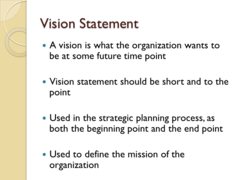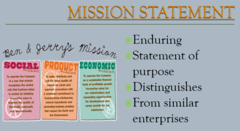Test Answers on Project Management Chapter 3 – Flashcards
Unlock all answers in this set
Unlock answersquestion
The projects overall goal and measure of success. It must align with the organization's objective, mission, and goals. The MOV MUST: *Be Measurable. *Provide Value to the Organization. *Be Agreed Upon *Be Verifiable
answer
Measurable Organizational Value
question
A vision statement articulates and inspires purpose

answer
Vision Statement
question
A solid project plan based on clear goals and identifiable tactics/tasks to reach them. Easier decision-making during the project (e.g. Does this feature/functionality align with our overall strategy?). Money saved with internal or external team efforts by reducing costly change requests or budget overruns caused by "surprise" variables.
answer
Project Alignment
question
Statement that clarifies what the organization does, who they do it for, and how or why they do it.

answer
Mission Statement
question
1. Identify the desired area of impact *Strategic *Customer *Financial *Operational *Social 2, Identify the desired value of the IT Project Better? Faster? Cheaper? Do more? 3. Develop an Appropriate Metric (numeric) ▪provides the project team with a performance target or directive ▪sets expectations among all stakeholders, and ▪affords a means for evaluating whether the project is a success later on. Marchewka, Jack T.. Information Technology Project Management, 5th Edition (Page 64). Wiley. Kindle Edition. 4. Time Frame for achieving MOV 5. Verify and Get Agreement from Stakeholders 6. Summarize the MOV in a clear concise statement The project will be successful if ______ Or use a time table (in year ___ we will ____, and so on)
answer
Six Basic Step for MOV
question
Time Period MOV 6 months 1 year 2 years
answer
MOV Statement Format
question
The business case defines why the project is being undertaken and provides the financial measurements
answer
Business Case
question
▪Ownership—A cross-functional team can spread a sense of ownership for the business case for more buy in and less problems. ▪Agreement—If you develop a business case in isolation, it is very likely that you will have to defend your assumptions and subjective judgments in a competitive or political setting. ▪Bridge building—The business case team may serve as an effective tool for handling critics of the business case.
answer
Advantages of Cross Functioning Team for Business Case
question
1: Define Measurable Organizational Value (MOV) 2: Form a Cross-Functional Business Case Team ▪Credibility—Access to people from various organizational areas or departments can provide critical expertise and information that may not be readily accessible to others outside that particular area. involved who will ask the right questions ▪Alignment with organizational goals—Higher level managers can help connect the business case with the organization's long-term strategic plan and mission. ▪Access to the real costs—The members of the business case team with certain expertise or access to important information can help build more realistic estimates with respect to salaries, overhead, accounting and reporting practices, training requirements, union rules and regulations, and laws. 3: Identify Alternatives 4: Define Feasibility and Assess Risk 5: Define Total Cost of Ownership—The 6: Define Total Benefits of Ownership—Similarly, 7: Analyze Alternatives 8: Propose and Support the Recommendation
answer
Steps for Developing a Business Case
question
Focuses on what can go wrong or what must go right. ▪Identification—What can go wrong? What must go right? ▪Assessment—What is the impact of each risk? ▪Response—How can the organization avoid or minimize the risk?
answer
Risk
question
Should focus on whether a particular alternative is doable and worth doing. Consider the following: *Economic Feasability *Technical Feasability *Organizational Feasability ▪Other feasibilities—Depending on the situation and the organization, a business case may include other issues, such as legal and ethical feasibility.
answer
Feasability
question
Total cost of ownership (TCO) is a concept that has gained widespread attention and generally refers to the total cost of acquiring, developing, maintaining, and supporting the product or application system over its useful life. TCO includes such costs as: ▪Direct or up-front costs—Initial purchase price of all hardware, software, and telecommunications equipment, all development or installation costs, outside consultant fees, etc. ▪Ongoing costs—Support, salaries, training, upgrades, supplies, maintenance, etc. ▪Indirect costs—Initial loss of productivity, time lost by users when the system is down, the cost of auditing equipment (i.e., finding out who has what and where), quality assurance, and postimplementation reviews.
answer
Total Cost of Ownership
question
Include all of the direct, ongoing, and indirect benefits associated with each proposed alternative. life. Benefits can arise from: ▪Increasing high-value work—For example, a salesperson may spend less time on paperwork and more time calling on customers. ▪Improving accuracy and efficiency—For example, reducing errors, duplication, or the number of steps in a process. ▪Improving decision making—For example, providing timely and accurate information. ▪Improving customer service—For example, new products or services, faster or more reliable service, convenience, and so on.
answer
Total Benefits of Ownershlp
question
▪Changing the existing business processes without investing in IT. ▪Adopting or adapting an application developed by a different area or department within the organization. ▪Reengineering the existing system. ▪Purchasing an off-the-shelf application package from a software vendor. ▪Custom building a new application using internal resources or outsourcing the development to another company.
answer
Considerations for Alternatives
question
Financial models focus on either profitability and/or cash flows. Cash flow models focus on the net cash, may be positive or negative, and are calculated by subtracting the cash outflows from the cash inflows. In general, one could view the benefits associated with a particular alternative as a source of cash inflow and the costs as the source of outflows. The most commonly used cash flow models include payback, breakeven, return on investment, and net present value..
answer
Financial Model
question
1. Return on Investment (ROI) 2. Future value (FV) 3. Net present value (NPV) 4. Payback period 5. Internal rate of return (IRR) 6. Cost-benefit analysis 7. Alternatives 8. Risk analysis
answer
Business Case Financial Measurements
question
Payback Period = Initial Investment∕Net Cash Flow = $100,000∕$20,000 = 5 years
answer
Payback
question
Breakeven Point = Initial Investment∕Net Profit Margin = $100,000∕$5 = 20,000 units
answer
Breakeven
question
Project ROI = Total Expected Benefits−Total Expected Costs Total Expected Costs = $115,000−$100,000 $100,000 = 15%
answer
ROI
question
Net Present Value (NPV)—NPV focuses on the time value of money..
answer
Net Present Value
question
The discount rate is the minimum return a company would expect from a project if the company were to make an equivalent investment in an opportunity of similar risk. Calculated using the formula: NPV = −I O + ∑( Net Cash Flow (1 + r) t ) Where: I = total cost (or investment) in the project r = discount rate t = time period
answer
Discount Rate (aka Hurdle Rate,
question
Scoring models provide a method for comparing alternatives or projects based on a weighted score. Total Score = ∑n i=1 wi ci Where: wi = criterion weight ci = criterion score 0≤wi ≤1
answer
Scoring Models
question
▪The scoring model can combine both qualitative and quantitative criterion ▪Weights and scores can be subjective ▪Financial models can be biased toward the short run ▪Some criteria can be reverse-scored ▪Past experience may help create a more realistic business case
answer
Benefits of Scoring Models
question
▪The project must align with the organization's values, vision, mission, and strategies. ▪The project must provide measurable organizational value that can be verified at the completion of the project.
answer
Project Selection Decision



